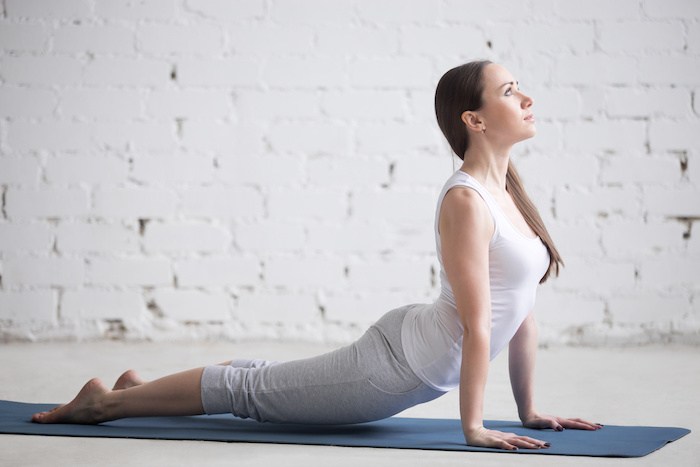One of my clients describes this as the best exercise
for shoulder and upper back tension.
He thinks it should be the first exercise that I give people,
regardless of their problem.
It really does reduce shoulder and upper back tension in a magical way. I noticed significant differences over the 1st month when I showed people how to do the exercise for shoulder tension. Everyone says that it relaxes the head and neck as well.

The Problem
Look at those shoulders. She’s working hard. She is leaning into the screen as she does a great job. But it stretches muscles that keep those shoulders down.

But it’s not just something we do when we’re stressed or focused. It becomes a habit of supporting ourselves with our elbows. And we stop using our backs to keep us upright.

Cars aren’t much better. We either keep our hands high at 10 and 2 or relax and lean into the armrests. The ergonomics accommodate our need to rest those high and tight shoulders.
There’s a lot that I could write on how to sit up straight. The screen should be at eye level. Hips above knees. Wrists resting on the counter. Elbows floating. Shoulders dropped. Coffee shops and almost all the other places aren’t built to adjust to each person’s stature. So we need an exercise that helps lower our shoulders. A simple one. Here it is.
The Breathing Exercise
Clients usually do this at their desks or while driving. I do it whenever I get to a traffic light. Ten reps. One of my clients does it whenever they get up to get coffee or go to the restroom. Also, ten reps. Here’s how you do the one in the car.

Time Needed : 1 minutes
u003cstrongu003eHere’s how to relax the shoulder and neck:u003c/strongu003eu003cbru003e
Sit up straight.
Get your head back over your hips as well as you can. Unfortunately, that probably means you’ll have to adjust your car seat or sit up straight in your chair.
Let your elbows dangle in space.
When I’m in the car, I usually take them off the armrests and hold the wheel at 4 and 8. When I’m using my laptop, I back away from the table to support my wrists, but my elbows are free.
Breathe out
Gently push down with your elbows as you breathe out. Just let them sink.
Breathe in
After exhaling, inhale with your diaphragm by letting your abdomen expand. Try not to let your shoulders come back up. I know they’ll want to come up a bit. Do the best you can.
Repeat steps 3-4 at least 10 times
Do this exercise at least 3 times a day. or a week. If you’re like most of my clients, you’ll be delightfully surprised.
Many people feel their shoulders are chronically high and tight, and they just won’t shift. This exercise uses a physiological principle called “reciprocal inhibition.” It says that when you contract a muscle, the opposing muscle tries to relax. This principle is used in Active Isolated Stretching.
Lots of muscles support high, tight shoulders. Levator scapula. Upper Trapezius. Middle Trapezius. Clavicular Pectoralis Major. Middle Serratus Anterior. There are more. The beauty is that you don’t have to worry about the stretch for each one or even remembering their names. This exercise automatically works on the one(s) that keep your shoulders elevated, and when those get stretched, it will work on the next tightest muscles.
I’d love your feedback on how this works for you and any suggestions you might have.
Email me at integrativeworks@gmail.com.
Yoga Corner

Look at this pose of Upward Dog. She’s done a great job of getting those shoulders down below the base of her neck. The objective is that your collar bones are level when you’re standing. If you Google pictures of Upward Dog, you’ll see that less than one in ten gets those shoulders down and collar bones level. This exercise will bring those shoulders down.
Support Integrative Works to
stay independent
and produce great content.
You can subscribe to our community on Patreon. You will get links to free content and access to exclusive content not seen on this site. In addition, we will be posting anatomy illustrations, treatment notes, and sections from our manuals not found on this site. Thank you so much for being so supportive.
Cranio Cradle Cup
This mug has classic, colorful illustrations of the craniosacral system and vault hold #3. It makes a great gift and conversation piece.
Tony Preston has a practice in Atlanta, Georgia, where he sees clients. He has written materials and instructed classes since the mid-90s. This includes anatomy, trigger points, cranial, and neuromuscular.
Question? Comment? Typo?
integrativeworks@gmail.com
Interested in a session with Tony?
Call 404-226-1363
Follow us on Instagram

*This site is undergoing significant changes. We are reformatting and expanding the posts to make them easier to read. The result will also be more accessible and include more patterns with better self-care. Meanwhile, there may be formatting, content presentation, and readability inconsistencies. Until we get older posts updated, please excuse our mess.

